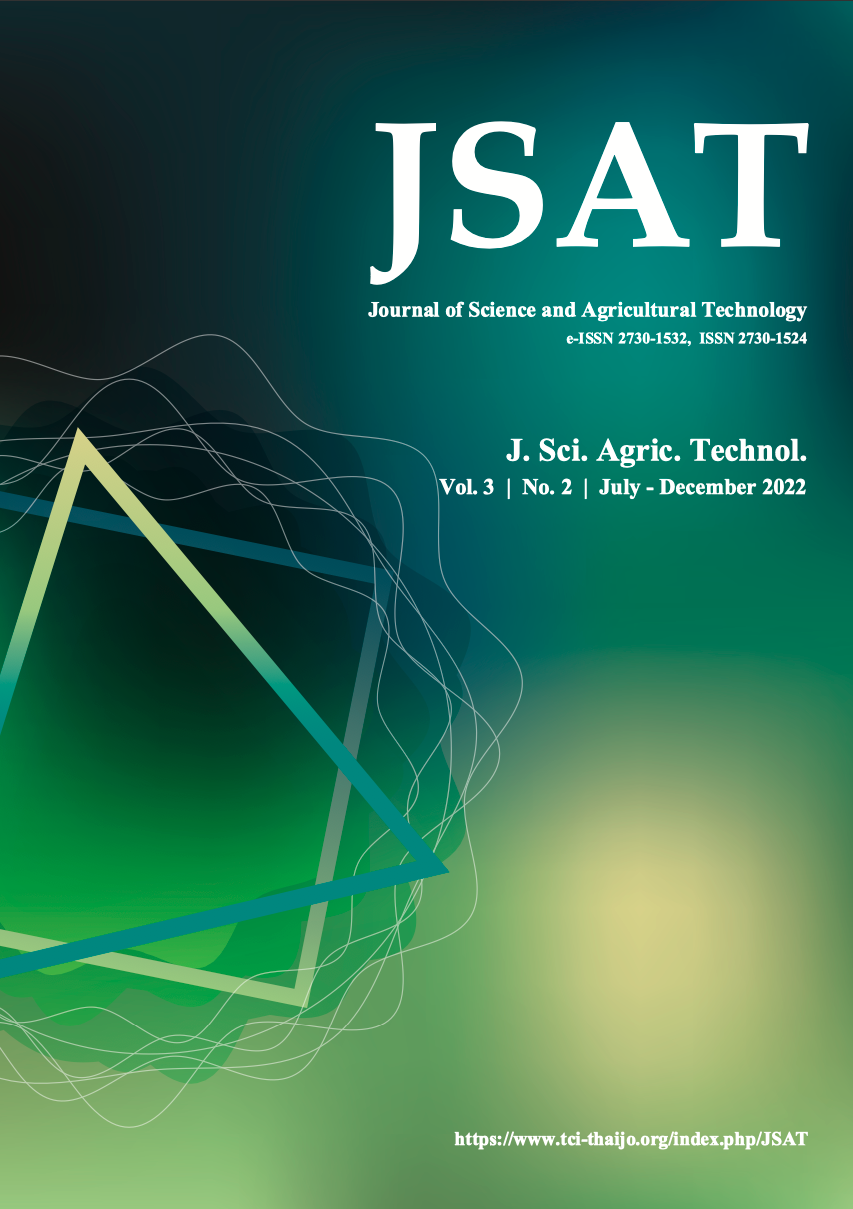Utilization of Carissa carandas Linn. aqueous extracts as reducing agent for traditional cotton fabrics dyeing with indigo from Strobilanthes cusia Nees
Main Article Content
Abstract
Article Details

This work is licensed under a Creative Commons Attribution-NonCommercial-NoDerivatives 4.0 International License.
References
Ahmed, S. A., Hanif, S., and Iftkhar, T. 2013. Phytochemical profiling with antioxidant and antimicrobial screening of Amaranthus viridis L. leaf and seed extracts. Open Journal of Medical Microbiology. 3: 164-171. https://doi.org/10.4236/ojmm.2013.33025.
Bhosale, S.V., Shete, R.V., Adak, V.S., and Murthy, K. 2020. A Review on Carissa carandas: traditional use, phytochemical constituents and pharmacological properties. Journal of Drug Delivery and Therapeutics. 10(6-s): 145-150. https://doi.org/ 10.22270/jddt.v10i6-s.4443.
Carrasco-SandovalIrene, J., Falco, I., Sanchez, G., Fabra, M.J., López-Rubio, A., Rodriguez, Henríquez-Aedo, K., and Aranda, M. 2022. Multivariable optimization of ultrasound-assisted extraction for the determination of phenolic and antioxidants compounds from arrayan (Lumaapiculata (DC.) Burret) leaves by microplate-based methods and mass spectrometry. Journal of Applied Research on Medicinal and Aromatic Plants. 28: 100356. https://doi.org/10.1016/j.jarmap.2021.100356.
Kheyrodin, H. 2009. Isolation and identification of new eleven constituents from medicinal plant. International Journal of Nutrition and Metabolism. 1(2): 014-019. https://doi.org/ 10.5897/IJNAM.9000021.
Khiya, Z., Oualcadi, Y., Gamar, A., Berrekhis, F., Zair, T., and Hilali, E.L. 2021. Correlation of total polyphenolic content with antioxidant activity of hydromethanolic extract and their fractions of the Salvia officinalis leaves from different regions of Morocco. Journal of Chemistry. Article ID 8585313. https://doi.org/10.1155/2021/8585313.
Khunchalee, J., and Charoenboon, P. 2019. Study of free radical scavenging, total phenolic contents and tyrosinase inhibition activity of crude extract from Carissa carandas Linn. SNRU Journal of Science and Technology. 11(1): 26-34.
Koyyati, R., Nagati, V. B., Nalvothula, R., Merugu, R., Kudle, K. R., Marx, P., and Padigya, P.R.M. 2014. Antibacterial activity of silver nanoparticles synthesized using Amaranthus viridis twig extract. International Journal of Research in Pharmaceutical Sciences. 5(1): 32-39.
Li, S., Cunningham, A.B., Fan, R., and Wang, Y. 2019. Identity blues: the ethnobotany of the indigo dyeing by Landian Yao (Iu Mien) in Yunnan, Southwest China. J Ethnobiology Ethnomedicine. 15: 13 https://doi.org/10.1186/s13002-019-0289-0.
Mongkholrattanasit, R., Kryštůfek, J., Wiener, J., and Studničková, J. 2011. Properties of wool and cotton fabrics dyed with eucalyptus, tannin and flavonoids. Fibres and Textiles in Eastern Europe. 85(2): 90-95.
Neimkhum, W., Anuchapreeda, S., Wei-Chao Lin, W-C., Lue, S-C., Lee, K-H., and Chaiyana, W. 2021. Effects of Carissa carandas Linn. fruit, pulp, leaf, and seed on oxidation, inflammation, tyrosinase, matrix metalloproteinase, elastase, and hyaluronidase inhibition. Antioxidants. 10(9): 1345. https://doi.org/10.3390/antiox10091345.
Obulesu, M., and Bhattacharya, S. 2011. Color changes of tamarind (Tamarindus indica L.) pulp during fruit development, ripening, and storage. International Journal of Food Properties. 14: 538-549. https://doi.org/10.1080/10942910903262129.
Pattanaik, L., Nail, S.N., Hariprasad, P., and Padhi, S.K. 2021. Influence of various oxidation parameter(s) for natural indigo dye formation from Indigofera tinctoria L. biomass. Environmental Challenges. 4: 100157. https://doi.org/10.1016/j.envc.2021.100157.
Sarkar, R., Kundu, A., Banerjee, K., and Saha, S. 2018. Anthocyanin composition and potential bioactivity of karonda (Carissa carandas L.) fruit: An Indian source of biocolorant. LWT-Food Science and Technology. 93: 673-678. https://doi.org/ 10.1016/j.lwt.2018.04.012.
Sasikumar, V., Subramaniam, A., Aneesh, A., and Saravanan, G. 2015. Protective effect of alkaloids from Amaranthus viridis Linn. against hydrogen peroxide induced oxidative damage in human erythrocytes (RBC). International Journal of Clinical Endocrinology and Metabolism. 1(1): 049-053.
Sassa-deepaeng, T., and Yodthong, W. 2019. Green synthesis of iron nanoparticles using plant crude extracts as reducer for removal of acriflavine. Proceeding of The 10th RMUTS International Conference "Creative Innovation and Technology for Sustainable Agriculture” by RMUT Lanna. Chiang Mai, Thailand. Retrieved from https://webs.rmutl.ac.th/assets/upload/files/2019/08/20190826152019_86838.pdf
Sassa-deepaeng, T., Yodthong, W., and Khamphira, T. 2019. synthesized copper nanoparticles and their anti-bacterial properties against bullfrog multidrug resistant gram negative bacteria. Veterinary Integrative Sciences. 17(1): 33-49.
Steel, R.G.D., Torrie, J.H. and Dicky, D.A. 1997. Principles and procedures of statistics, a biometrical approach. 3rd ed., McGraw Hill, Inc. Book Co., New York.
Yodthong, W., Chaiwongsar, S., Wanachantararak, P., Keereeta, Y., Panthuwat, W., Saovapha, B., and Sassa-deepaeng, T. 2020a. Influence of different extraction solvents on antioxidant and antityrosinase activities of Morus alba Linn. leave extract. Journal of Science and Agricultural Technology. 1 (1): 7-17. https://doi.org/10.14456/jsat.2020.2.
Yodthong, W., Nuanmanee, S., Wanachantararak, P., Khumpirapang, N., and Sassa-deepaeng, T. 2020b. The extraction of estrogen-like compounds from Pueraria mirifica, the properties characterization and the preparation of nucleated nanoparticles. Journal of Science and Agricultural Technology. 1 (2): 7-13. https://doi.org/10.14456/jsat.2020.7.


